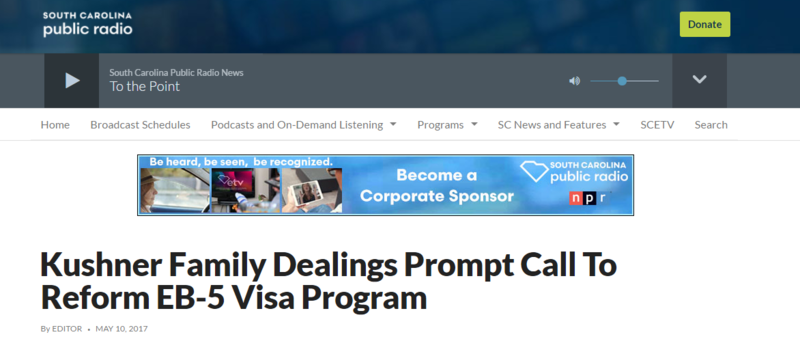Kushner Family Dealings Prompt Call To Reform EB-5 Visa Program
ROBERT SIEGEL, HOST:
More now on the EB-5 Immigrant Investor Visa Program. Professor Stephen Yale-Loehr teaches immigration law practice at Cornell University. He's a supporter of the EB-5 visa program, although he says Congress ought to make some changes to it. Professor Yale-Loehr joins us from Ithaca, N.Y. Welcome.
STEPHEN YALE-LOEHR: Glad to be here.
SIEGEL: Before getting into any specifics, I want to ask you about the general impression that this program gives to many people. It sounds like the platinum version of the Statue of Liberty's offer - give me your rich, your high-rollers eager to jump the queue for a visa. Do you have any problem with that impression of how people get to live here?
YALE-LOEHR: Well, this is a very small program in a very large immigration system. We hand out about a million green cards each year, and 10,000 of those are set aside for the EB-5 program. And actually, it's not 10,000 investors, it's about one-third of those because the 10,000 number includes spouses and children of investors.
So we're talking about one half of 1 percent of all people who are coming into the United States each year on this program. And they are creating jobs for U.S. workers at no expense to the taxpayer. And they're helping the economy in other ways, so done properly it is a good idea.
SIEGEL: Actually, the program really took off about 10 or 12 years ago. And again, that's relative to a small number of visas. U.S. property developers for the most part found that foreign investors were willing to put up either a million dollars or half a million dollars expecting smaller returns because the real return is the right for them and their families to live in the U.S. Is that, however limited it may be, a program that is selling green cards to people?
YALE-LOEHR: In one sense it is selling green cards, but we're getting a lot of benefits from that green card program. The Commerce Department estimated that 174,000 jobs were created for U.S. workers in 2012 and 2013 just from the EB-5 program. And that accounted for 4.3 percent of the U.S. job growth during those two year periods.
So we were just recovering from the recession, and the EB-5 was really helping to move the needle on job growth in that time period. So again, it has to be done correctly, but if it is, then it can really help the economy.
SIEGEL: I've read, though, critical reports of the program, both by the Government Accountability Office and also the inspector general of the Department of Homeland Security. I read about one project where 18 percent of the capital came from EB-5 investors, and 100 percent of the project's jobs were attributed to them because you have to show that your money is putting 10 people into full-time jobs.
The West Side of Manhattan can be declared an economically deprived area by drawing the right map around it. Is this a program that really can be policed, or is it just too ripe for corruption and fooling around?
YALE-LOEHR: It can be policed, and it should be policed. This program was set up by Congress back in 1990 because other countries had similar immigrant investor programs, and we wanted to get into the game. And, you know, it hasn't really been modified since then. And there have been a lot of changes that Congress needs to make.
Certainly, I would agree that we need to restrict the ability of projects to be in luxury areas like Midtown Manhattan. And there are proposals in Congress that would restrict that ability. And I think that would be good for the program if Congress can do that.
SIEGEL: What ought to be changed about the EB-5 program? If you could sum up in - very briefly what reforms should be enacted, what would they be?
YALE-LOEHR: I'd say there are four reforms. Number one, we need more oversight by both the Securities and Exchange Commission and the U.S. Immigration Agency. Number two, we do need to restrict the ability of projects to operate in areas that are not truly distressed and urban centers.
Number three, we need to increase the minimum investment amount from the original $500,000 to some higher amount that is equivalent from 1990 to today. And fourth, we probably should have some visas set aside for projects in rural areas so that those kinds of projects are more likely to attract investors' attention.
SIEGEL: That's Professor Steve Yale-Loehr of Cornell University. Thanks for talking with us.
YALE-LOEHR: I was very happy to do so.
Mentions
Videos





Subscribe for News
Site Digest
Join Professionals on EB5Projects.com →
Securities Disclaimer
This website is for informational purposes only and does not constitute an offer or solicitation to sell shares or securities. Any such offer or solicitation will be made only by means of an investment's confidential Offering Memorandum and in accordance with the terms of all applicable securities and other laws. This website does not constitute or form part of, and should not be construed as, any offer for sale or subscription of, or any invitation to offer to buy or subscribe for, any securities, nor should it or any part of it form the basis of, or be relied on in any connection with, any contract or commitment whatsoever. EB5Projects.com LLC and its affiliates expressly disclaim any and all responsibility for any direct or consequential loss or damage of any kind whatsoever arising directly or indirectly from: (i) reliance on any information contained in the website, (ii) any error, omission or inaccuracy in any such information or (iii) any action resulting therefrom.



